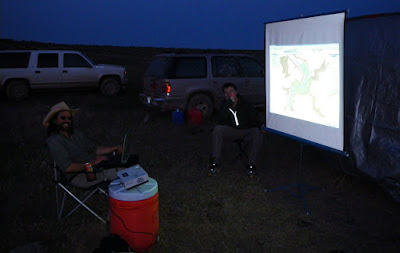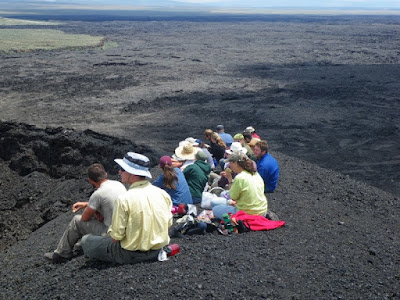It is crunch time on the map. I have so many other maps to work on that I need to begin seriously riding the asymptote to the completion of this one. After many years of solo and collective field observations and various consultations, arguments, and friendly exchanges with most of the Yeehows, I have settled on this list. If you have grave concerns please, please, oh please let me know sooner rather than later. I will throw the correlation diagram up soon.
Hillslope Deposits
Qcf Undivided colluvium and alluvial fan deposits, Holocene to Pleistocene
Qc Colluvium, undivided, Holocene to Pleistocene
Eolian Deposits
Qe Eolian sediments, Holocene to late Pleistocene(?)
Deposits of the Owyhee River
Qra Active channel and floodplain alluvium, Recent to late Holocene
Qry Young fluvial sediments, Holocene
Qrty Young floodplain terraces, Holocene
Qrt1-n Fluvial terrace gravels, Pleistocene (numbered in local depositional order where appropriate)
Qrg Fluvial gravel, undivided, Pleistocene
Qgb Fluvial boulder bars, Pleistocene
Qgw Fluvial gravel of West Crater lava, late Pleistocene
Qrgo Older fluvial gravel, Pleistocene
Qgbr Fluvial gravels of Bogus Rim lava, early Pleistocene
QTgl Ancient, inter-lava flow fluvial gravel, early Pleistocene to Pliocene
QTga Fluvial gravel of Artillery rim, early Pleistocene to Pliocene(?)
Lacustrine deposits of the Owyhee River corridor
Qfl Fluvio-lacustrine sediments, undivided, late Pleistocene
Qflw Fluvio-lacustrine sediments of West Crater lava dam, late Pleistocene
Qfls Fluvio-lacustrine sediments of Saddle Butte lava dam, late Pleistocene
QTfa Fluvio-lacustrine sediments of Artillery Rim, early Pleistocene to Pliocene
Landslide Deposits
Qls Landslide deposits, undivided, Holocene to early(?) Pleistocene
Qlsy Young landslide deposits, Holocene to late Pleistocene
Qlsby Young landslide deposits composed dominantly of coarse basalt breccia, Holocene to late Pleistocene
Qlsi Intermediate age landslide deposits, late Pleistocene
Qlso Old landslide deposits, middle to early (?) Pleistocene
Alluvium of Owyhee River tributaries and local drainages
Qa Alluvium of tributary washes and alluvial fans, undivided, Holocene to Pleistocene
Qas Alluvium and related sediments of active springs, Holocene to late Pleistocene
Qad Alluvium of closed depressions and sags, Holocene to late Pleistocene
Qay Young alluvium of tributary washes and alluvial fans, Recent to Holocene
Qai Intermediate age alluvium of tributary washes and alluvial fans, late Pleistocene
Qao Old alluvium of tributary washes and alluvial fans, middle to early Pleistocene
QTa Ancient alluvium of tributary washes and alluvial fans, early Pleistocene to Pliocene
Basalt lavas of the Owyhee River corridor and surrounding areas
Qbcp Basalt of Coffee Pot Crater, Holocene*
Qbrb Basalt of Rocky Butte, Holocene (?) to late Pleistocene*
Qbw Basalt of West Crater, Pleistocene
Qbs Basalt of Saddle Butte
Qbsy Younger basalt of Saddle Butte
Qbso Older basalt of Saddle Butte
Qbc Basalt of Clarks Butte
Qbg Basalt of Greely bar, early Pleistocene
Qbr Basalt of Bogus Rim, early Pleistocene
QTbc Basalt of Bogus cliffs, early Pleistocene to Pliocene
QTb Basalt, undivided, early Pleistocene to Pliocene
Tb Undivided basalt lavas, Pliocene to Miocene (?)
Tbs Undivided basalt lavas and interbedded sediments, Miocene to Pliocene
*These lavas only on regional map, not in river corridor
Rhyolite lavas and sedimentary rocks
Tsv Interbedded volcanic, volcaniclastic, and other sedimentary rocks, Miocene
Tr Undifferentiated rhyolite lavas, Miocene

 The slope-shading method looks a bit less 'real' but provides an amazing enhancement of slope contrasts that reflect important contact relations. Try it out on the data yourself and you will be amazed at the new array of relations that will jump out at you. For example, look at the young landslide nested in a larger slide along the Saddle Butte lava flow in the lower left corner. Pretty obvious now, no? Probably blocked the channel. During field camp, I found one of these in the Artillery Rim complex that is nested in the older slide complex. It too flanks a notably narrow reach of the river and may be associated with a young blockage.
The slope-shading method looks a bit less 'real' but provides an amazing enhancement of slope contrasts that reflect important contact relations. Try it out on the data yourself and you will be amazed at the new array of relations that will jump out at you. For example, look at the young landslide nested in a larger slide along the Saddle Butte lava flow in the lower left corner. Pretty obvious now, no? Probably blocked the channel. During field camp, I found one of these in the Artillery Rim complex that is nested in the older slide complex. It too flanks a notably narrow reach of the river and may be associated with a young blockage.













